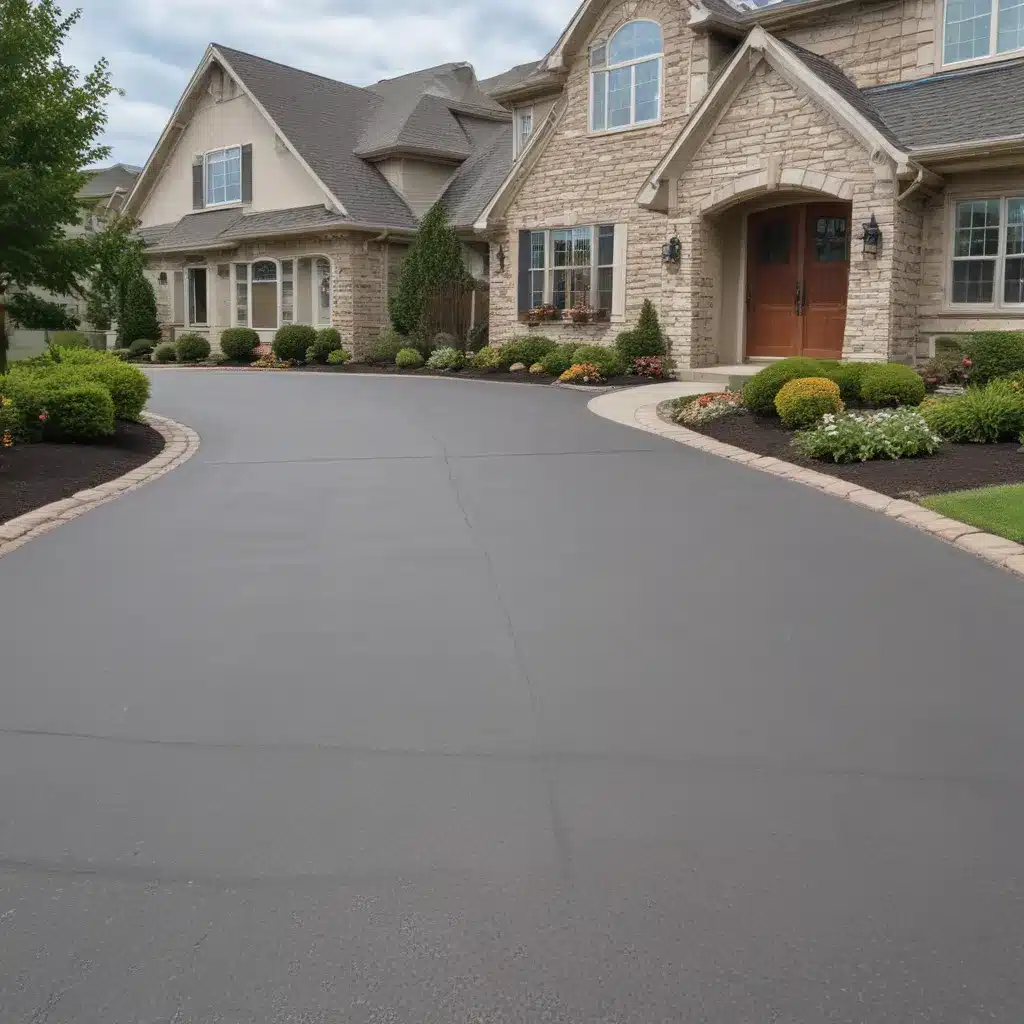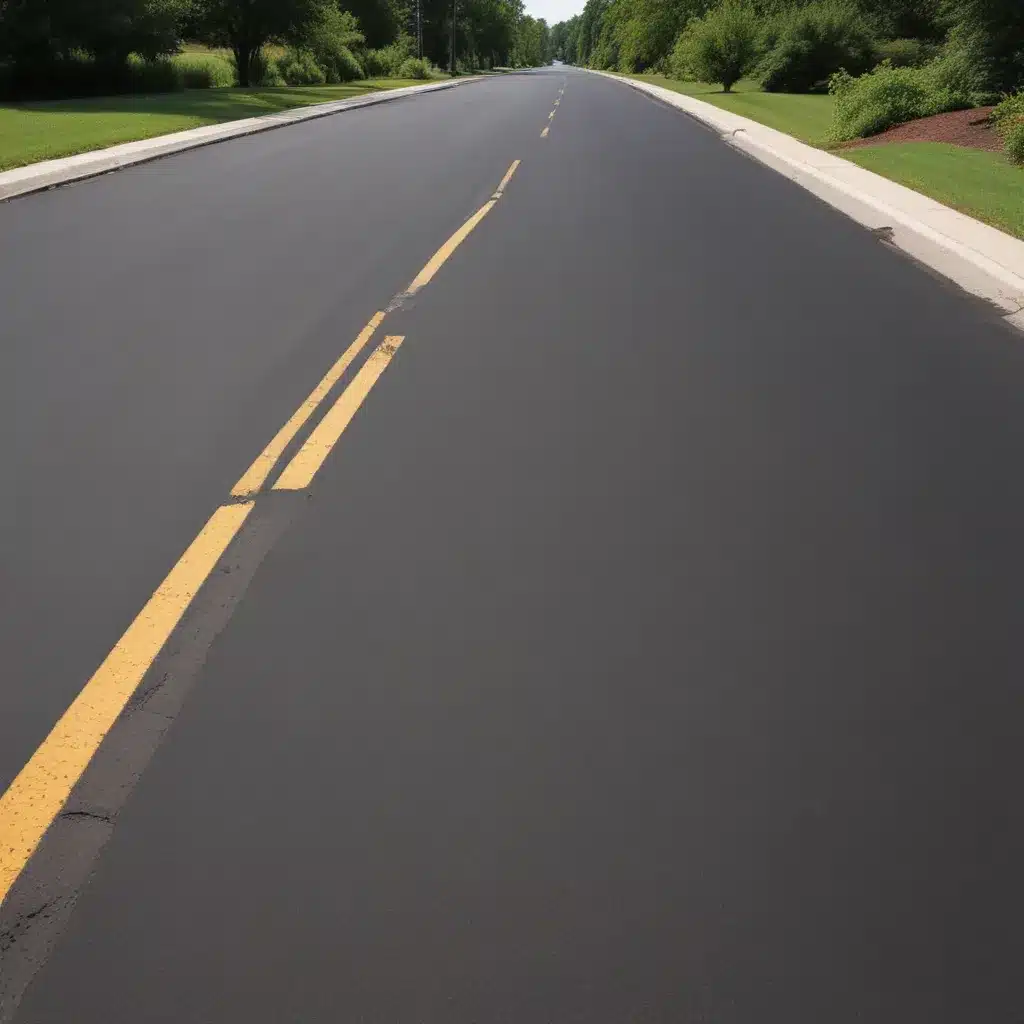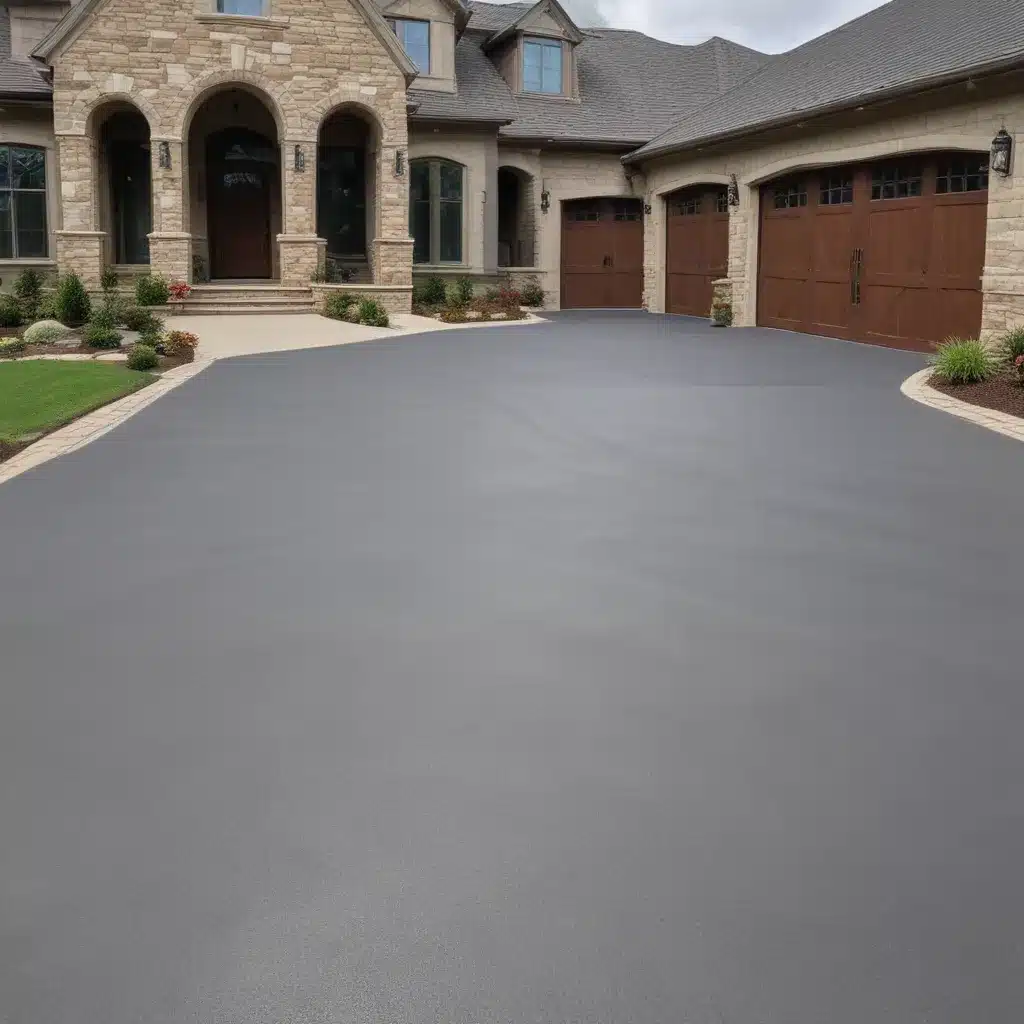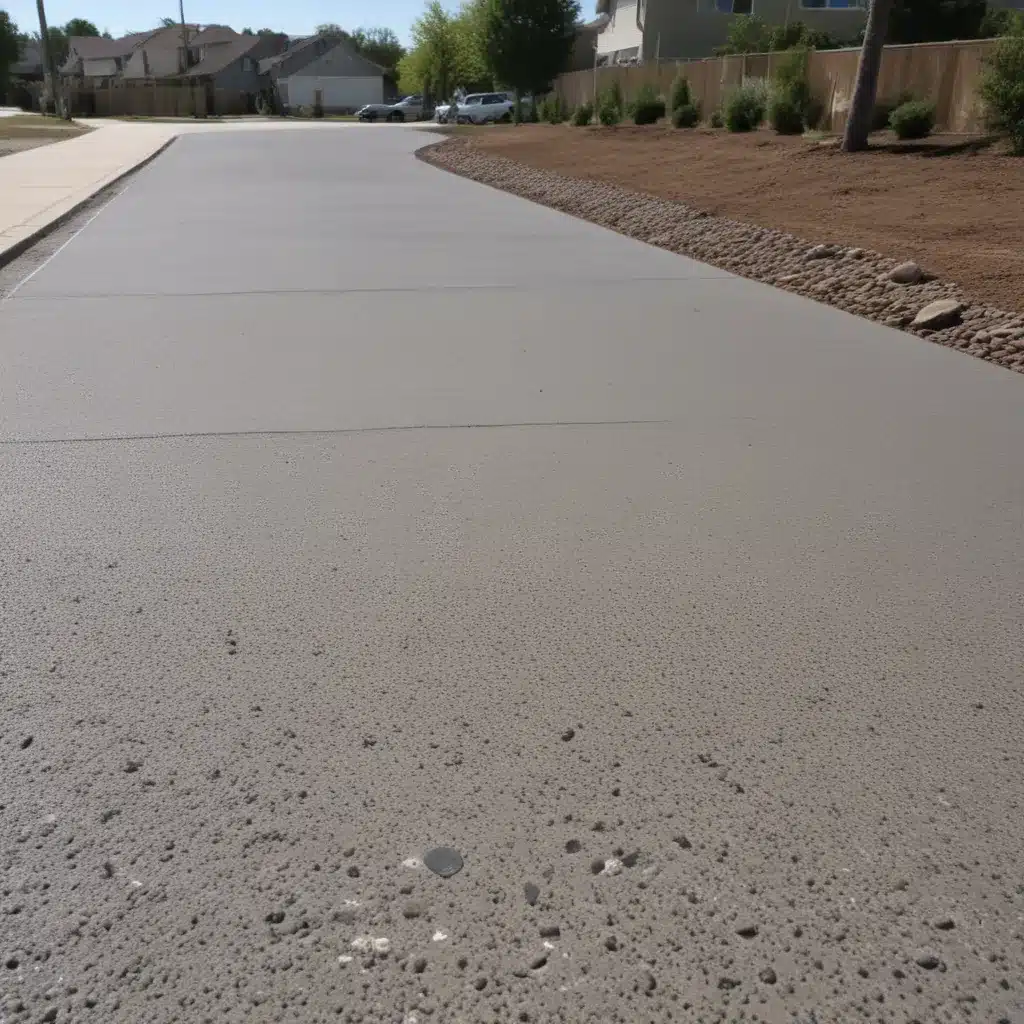The Plight of Traditional Driveways
Ah, the humble driveway – that often-overlooked stretch of pavement leading up to our homes. We tend to think of it as a mere utilitarian necessity, a functional feature we hardly ever give a second thought. But have you ever stopped to consider the impact our driveways have on the environment?
I certainly didn’t, until I started digging a little deeper. You see, the vast majority of driveways out there are made of traditional materials like concrete or asphalt. And let me tell you, those substances are anything but eco-friendly. The production of concrete, for example, is a major contributor to greenhouse gas emissions, while asphalt is derived from crude oil – a non-renewable resource that’s wreaking havoc on our planet.
Moreover, these traditional driveway materials are impermeable, meaning they don’t allow water to soak into the ground. Instead, they funnel rainwater and snowmelt directly into nearby storm drains, often carrying pollutants and debris with them. This can lead to issues like urban flooding, soil erosion, and the disruption of local ecosystems. Yikes, talk about an inconvenient truth!
But fear not, my environmentally-conscious friends. There’s a greener, more sustainable solution to our driveway woes – and that’s what this guide is all about. So, strap in and get ready to learn how you can build an eco-friendly driveway that won’t cost the earth (pun intended).
The Beauty of Permeable Pavement
The key to an environmentally-friendly driveway lies in choosing the right materials. And when it comes to green options, permeable pavement is definitely the way to go.
You see, permeable pavement is designed to allow water to filter through, rather than running off the surface. This not only helps to reduce stormwater runoff and the risk of flooding, but it also recharges groundwater supplies and prevents the accumulation of pollutants. It’s a win-win for both the environment and your property!
There are several types of permeable pavement to choose from, each with its own unique benefits. Porous concrete, for example, has a special mix that allows water to seep through while still providing a sturdy, durable surface. Permeable pavers, on the other hand, are individual blocks or stones that are spaced apart to create gaps for water infiltration. And then there’s gravel, which may not be as sleek as its paved counterparts, but it’s an excellent choice for those looking to achieve a natural, rustic aesthetic.
No matter which permeable option you go for, you’ll be doing your part to reduce your environmental footprint and create a more sustainable driveway. And let’s not forget the added bonus of lower maintenance – no more worrying about cracks, potholes, or that unsightly weeds popping up between the pavement!
The Perks of Porous Pavement
Now, I know what you’re thinking – “But won’t permeable pavement be more expensive than traditional driveway materials?” And you know what? You’d be right. Permeable pavement does tend to come with a slightly higher price tag.
However, I’d argue that the long-term benefits far outweigh the initial cost. Think about it this way: by choosing a permeable driveway, you’re investing in the health of your local environment and reducing the strain on our overburdened stormwater infrastructure. Plus, with lower maintenance requirements and a longer lifespan, you’ll end up saving money in the long run.
And let’s not forget the aesthetic appeal of permeable pavement. These materials come in a wide range of colors, textures, and patterns, allowing you to create a truly unique and eye-catching driveway. Imagine pulling up to your home and being greeted by a beautifully-designed, environmentally-friendly driveway that’s the envy of the entire neighborhood. Talk about curb appeal!
But the perks of porous pavement don’t stop there. Did you know that these materials can also help to reduce the urban heat island effect? By allowing water to infiltrate the ground, permeable driveways can help to lower surface temperatures and mitigate the warming caused by all those impermeable surfaces in our cities and suburbs. It’s like having your very own pocket-sized oasis right outside your front door.
The Importance of Proper Installation
Now, I know what you’re thinking – “Okay, I’m sold on the idea of a permeable driveway. But how do I make sure it’s installed correctly?” And let me tell you, proper installation is absolutely crucial when it comes to ensuring the long-term success of your eco-friendly driveway.
You see, permeable pavement requires a bit more preparation and attention to detail than traditional materials. The base and sub-base need to be carefully engineered to allow for proper water infiltration, and the pavement itself must be laid with precision to prevent any gaps or unevenness. Failing to do so can lead to all sorts of issues, from premature degradation to the dreaded clogging of the porous surface.
That’s why it’s so important to work with a reputable, experienced contractor who specializes in permeable pavement installation. These pros know all the ins and outs of the process, from selecting the right materials to ensuring proper drainage and maintenance.
And let me tell you, finding the right contractor can be a bit like navigating a minefield. There are a lot of fly-by-night operators out there who are more interested in a quick buck than delivering a top-notch, long-lasting product. That’s why it’s crucial to do your due diligence, check references, and ask plenty of questions before committing to a particular company.
But trust me, it’s all worth it in the end. With a properly installed permeable driveway, you’ll be able to enjoy all the environmental benefits, low-maintenance perks, and aesthetic appeal for years to come. It’s like having your very own slice of eco-paradise right outside your front door.
Maintaining Your Permeable Driveway
Alright, so you’ve taken the plunge and installed your shiny new permeable driveway. Congratulations, you eco-warrior, you! But now, the real work begins – maintaining that bad boy to keep it looking and functioning at its best.
You see, permeable pavement is a bit different from its traditional counterparts. While it may require a little more TLC, the payoff in terms of environmental benefits is well worth the effort. And trust me, with the right maintenance routine, you can keep your driveway looking as good as new for years to come.
One of the most important things to remember is that permeable surfaces need to be kept clear of debris and sediment. That means regular sweeping or vacuuming to remove any dirt, leaves, or other gunk that could clog up the porous surface. And don’t even think about using a pressure washer – that’s a surefire way to damage the pavement and disrupt the water infiltration process.
Speaking of water infiltration, it’s also crucial to make sure your driveway’s drainage system is functioning properly. This might involve periodically inspecting and clearing any blockages in the gravel or sand layers below the surface. And if you notice any ponding or standing water, it’s time to call in the experts to diagnose and resolve the issue.
But it’s not all hard work and elbow grease, my friends. One of the perks of a permeable driveway is that it’s actually pretty low-maintenance compared to traditional pavement. No more worrying about cracks, potholes, or that unsightly weed growth – just a little regular TLC to keep it looking its best.
And let’s not forget the joy of watching that rainwater soak into the ground, nourishing the earth and reducing the strain on our local stormwater systems. It’s like having a front-row seat to the circle of life, right in your own driveway. Talk about a win-win!
The Future of Sustainable Driveways
As I’ve hopefully made clear throughout this guide, the future of driveways is decidedly green. And I don’t just mean in terms of their environmental impact – I’m talking about a whole new world of innovative, sustainable materials and technologies that are changing the game.
Take, for example, the rise of recycled plastic pavement. This cutting-edge material is made by melting down and repurposing plastic waste, creating a durable, permeable surface that’s both eco-friendly and visually striking. Imagine pulling up to your home and being greeted by a driveway that’s not only good for the planet, but also a unique, eye-catching feature.
And that’s just the tip of the iceberg. Researchers are constantly exploring new ways to make our driveways more sustainable, from experimenting with solar-powered pavement that can generate renewable energy, to developing self-healing materials that can repair cracks and potholes without the need for costly maintenance.
But it’s not just about the materials, folks. The way we design and construct our driveways is also undergoing a green revolution. Concepts like stormwater management, urban heat island mitigation, and habitat restoration are all being integrated into the planning process, creating driveways that don’t just look good, but actively work to improve the health of our local environments.
So, what does all this mean for you, the homeowner? Well, it means that the future of sustainable driveways is bright, and the time to get on board is now. Whether you’re building a new home or looking to revamp your existing driveway, there’s never been a better time to explore the world of eco-friendly pavement solutions.
And who knows – maybe your driveway could even become a source of community pride, inspiring your neighbors to follow suit and create a greener, more resilient neighborhood. After all, small steps can lead to big changes, and every permeable driveway is a step in the right direction.
So, what are you waiting for? Let’s build a better, more sustainable future, one driveway at a time.





